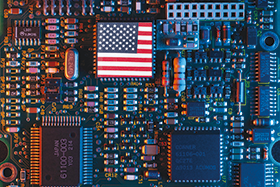

Recently, the CHIPS and Science Act was signed into US law, a $280 billion bill that paves the way for new chip foundries to be built on US soil.
Recently, the CHIPS and Science Act was signed into US law, a $280 billion bill that paves the way for new chip foundries to be built on US soil. This is a significant investment in the US semiconductor industry with $52 billion specifically targeting manufacturing and research, the repercussions thereof due to be felt in all parts of the globe.
The recent global pandemic showed us a few painful weaknesses of the globalisation that the world is currently facing. Shortages of components and rising prices were rife as demand outstripped supply. The new CHIPS Act seeks to address these shortfalls by allowing eggs to be spread over many baskets.
Right now, a large proportion of chip manufacturing takes place in East Asia.
Before the pandemic, this system worked relatively smoothly with no one caring that the company designing the products were far removed from the companies actually manufacturing those products. But after the introduction of COVID and the supply chain disruptions that it caused, many components were simply not available which caused a world-wide shortage. In a nutshell, when countries in the East Asia region get a cold, the rest of the engineering world suffers as well.
If the CHIPS Act does its job, more semiconductors will be manufactured on US soil which means that a major global event or even political uncertainty in a specific region will hopefully not cause a similar shortage to the one recently seen. Although seeing US-based semiconductor foundries are still a few years off, what is more exciting is that a large proportion of the funds (around $13 billion) are dedicated not to the building of these foundries, but rather to R&D; and addressing supply chain concerns. Much of these funds will be channelled into research in quantum information science, artificial intelligence, cybersecurity and advanced communication technologies.
Further to this, another $10 billion has been earmarked for the creation of innovation and technology hubs to help spur on the generation of technology hotspots. In fact, only about 20% of the total funds set aside by the CHIPS Act focuses on chip manufacturing. A huge portion of the funds seeks to revitalise scientific research and development.
Education has not been overlooked either. Around $13 billion has been set aside to aide students in the STEM fields of study ranging from school level, through college to graduate studies. This is vital if a qualified workforce is to be available to work in these design and manufacturing companies in the next decade onwards.
This investment will have a positive spinoff, not only for the design and manufacturing companies involved, but also for every common person worldwide who enjoys the benefit of this new digital age. Let’s hope that the implementation of this Act will not slow down due to bureaucracy and red tape.
© Technews Publishing (Pty) Ltd | All Rights Reserved